The SiGe:C HBT market, valued at USD 109.0 million in 2025, is expected to reach USD 181.0 million by 2035, with a CAGR of 5.2%. From 2021 to 2025, the market is expected to experience steady growth, increasing from USD 84.6 million in 2021 to USD 109.0 million in 2025. This early phase of growth is characterized by a gradual increase in demand, with the market reaching USD 89.0 million in 2022, USD 93.6 million in 2023, USD 98.5 million in 2024, and USD 103.6 million in 2025. This period is driven by the increasing demand for SiGe:C HBTs in high-speed communications, automotive, and consumer electronics, as well as the growing trend of integrating advanced semiconductor technologies.
Between 2026 and 2030, the market momentum strengthens, with values rising from USD 109.0 million in 2025 to USD 140.5 million in 2030. Annual growth rates increase slightly during this period, reflecting the growing adoption of SiGe:C HBTs in 5G communications, radar systems, and other high-frequency applications. As industries continue to shift toward more efficient and high-performance components, SiGe:C HBTs, known for their superior speed, power efficiency, and thermal performance, are being increasingly integrated into next-generation technologies. By 2035, the market is expected to reach USD 181.0 million, with intermediate values passing through USD 147.8 million, USD 155.4 million, and USD 163.5 million. The market’s growth momentum is driven by technological advancements and the expanding role of SiGe:C HBTs in next-generation communication and computing systems.
| Metric | Value |
|---|---|
| Estimated Value in (2025E) | USD 109.0 million |
| Forecast Value in (2035F) | USD 181.0 million |
| Forecast CAGR (2025 to 2035) | 5.2% |
The semiconductor market is the largest contributor, accounting for around 35–40%, as SiGe:C HBTs are widely used in high-speed, high-frequency applications, such as RF (radio frequency) communication, signal processing, and power amplifiers in mobile devices and telecommunications. The telecommunications market follows with a contribution of approximately 20–25%, as SiGe:C HBTs are essential components in base stations, cellular networks, and 5G technologies, offering high performance and efficiency in wireless communication systems. The consumer electronics market represents about 15–18%, as SiGe:C HBTs are increasingly used in smartphones, wireless devices, and wearable technologies that require high-frequency operation and low power consumption. The automotive market contributes around 10–12%, driven by the growing demand for advanced driver-assistance systems (ADAS) and in-vehicle communication systems, where SiGe:C HBTs enable high-speed data processing and signal transmission. The aerospace and defense market accounts for approximately 8–10%, as SiGe:C HBTs are used in radar systems, satellite communication, and other high-reliability applications that require robust performance in harsh environments.
Market expansion is being supported by the increasing global demand for high-performance wireless communication systems and the corresponding need for advanced semiconductor solutions that can maintain superior electrical characteristics while enabling efficient power management across various RF and microwave applications. Modern telecommunications manufacturers are increasingly focused on implementing semiconductor technologies that can support higher data rates, minimize signal distortion, and provide consistent performance in next-generation communication infrastructure. SiGe:C HBT components' proven ability to deliver exceptional high-frequency performance, improved linearity, and enhanced power efficiency make them essential building blocks for contemporary wireless communication and RF amplification solutions.
The growing emphasis on 5G network deployment and satellite communication infrastructure expansion is driving demand for SiGe:C HBT components that can support advanced modulation schemes, handle high-power applications, and enable reliable signal processing in challenging operating environments. RF system designers' preference for semiconductor solutions that combine superior electrical performance with thermal stability and manufacturing scalability is creating opportunities for innovative SiGe:C HBT implementations. The rising influence of aerospace and defense applications requiring high-reliability components is also contributing to increased adoption of SiGe:C HBT technology that can provide exceptional performance consistency without compromising operational reliability or system integration flexibility.
Opportunity Pathways - SiGe:C HBT Market
The SiGe:C HBT (Silicon-Germanium Carbon Heterojunction Bipolar Transistor) market represents a specialized yet rapidly expanding semiconductor opportunity driven by 5G infrastructure deployment, advanced wireless communication adoption, and the proliferation of high-frequency RF applications. As telecommunications equipment manufacturers seek superior linearity, enhanced power efficiency, and exceptional high-frequency performance, SiGe:C HBT technology is transitioning from niche applications to critical enabling components across wireless infrastructure, automotive radar, satellite communication, and IoT connectivity solutions.
The convergence of 5G rollouts, millimeter-wave communications, and Industry 4.0 connectivity requirements creates demand drivers across multiple end-markets. Geographic expansion opportunities are particularly pronounced in Asia-Pacific, where China (7.0% CAGR) and India (6.5% CAGR) lead global growth through massive telecommunications infrastructure investments and manufacturing scale-up initiatives.
Technology differentiation through advanced fabrication processes, carbon doping optimization, and thermal management integration enables premium positioning, while application diversification beyond traditional WLAN/UWB/Bluetooth markets into aerospace, automotive, and satellite communication opens new revenue streams with higher margin potential as the market expands from USD 109.0 million in 2025 to USD 181.0 million by 2035.
5G network deployment and millimeter-wave technology adoption create massive opportunities for specialized SiGe:C HBT components offering superior high-frequency performance and power efficiency. Base station manufacturers, small cell providers, and infrastructure equipment companies require advanced RF solutions supporting enhanced modulation schemes, higher data rates, and reliable signal processing. This pathway encompasses both sub-6GHz and mmWave frequency bands, with particular growth in urban dense networks and industrial IoT applications requiring consistent performance in challenging environments. Expected revenue pool: USD 35-50 million
Rapid telecommunications infrastructure growth across China (7.0% CAGR), India (6.5% CAGR), and emerging ASEAN markets creates substantial expansion opportunities through local manufacturing partnerships, technology transfer agreements, and regional supply chain development. Government initiatives supporting semiconductor industry development, 5G infrastructure deployment, and electronics manufacturing provide structural demand drivers. Localization strategies reduce costs, enable faster customer response, and position companies advantageously against import-dependent competitors while accessing growing domestic markets. Expected revenue pool: USD 40-60 million
Growing autonomous vehicle development, advanced driver assistance systems (ADAS), and vehicle-to-everything (V2X) communication requirements drive demand for specialized SiGe:C HBT components offering precision radar performance and reliable automotive-grade operation. This pathway addresses 77GHz automotive radar, adaptive cruise control, collision avoidance systems, and emerging autonomous driving platforms where consistent RF performance directly impacts safety and functionality. Premium pricing reflects automotive qualification requirements and long product lifecycles. Expected revenue pool: USD 25-35 million
Expanding satellite constellation deployments, space-based internet services, and defense communication systems create opportunities for specialized SiGe:C HBT solutions offering high reliability, radiation tolerance, and consistent performance across extreme operating conditions. This pathway encompasses low-earth orbit (LEO) satellites, military communication systems, radar applications, and emerging space-based services requiring components meeting stringent aerospace qualification standards and offering extended operational lifespans. Expected revenue pool: USD 20-30 million
Development of intelligent power management solutions and multi-standard communication platforms creates opportunities for integrated SiGe:C HBT components supporting multiple wireless protocols, adaptive power control, and enhanced battery life in portable devices. This pathway addresses the growing complexity of modern wireless systems requiring seamless integration across WLAN, Bluetooth, UWB, and cellular standards while maintaining optimal power efficiency and signal quality across diverse operating scenarios. Expected revenue pool: USD 15-25 million
Industry 4.0 adoption and industrial IoT expansion drive demand for reliable, high-performance RF solutions supporting machine-to-machine communication, wireless sensor networks, and smart factory connectivity. This pathway encompasses industrial wireless protocols, process automation communication, predictive maintenance systems, and smart grid applications where consistent RF performance enables critical industrial operations. Premium positioning reflects industrial qualification requirements and long replacement cycles. Expected revenue pool: USD 18-28 million
Investment in next-generation fabrication technologies, carbon doping optimization, and thermal management innovations enables differentiation through superior electrical characteristics, improved manufacturing yields, and cost-effective production scaling. This pathway encompasses epitaxial growth advancement, precision process control, automated testing systems, and quality assurance technologies that support premium product positioning while enabling competitive cost structures for volume applications across multiple market segments. Expected revenue pool: USD 12-20 million
The market is segmented by input power rating, application, and region. By input power rating, the market is divided into Maximum RF Input Power: Less Than 20 dBm, Maximum RF Input Power: 20–25 dBm, Maximum RF Input Power: Above 25 dBm, and others. Based on application, the market is categorized into WLAN, UWB, and Bluetooth, satellite communication, and multimedia. Regionally, the market is divided into North America, Europe, Asia Pacific, Latin America, and the Middle East & Africa.
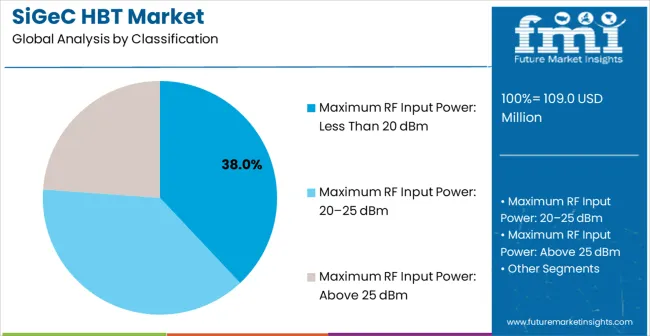
The Maximum RF Input Power: Less Than 20 dBm segment is projected to account for 38% of the SiGe:C HBT market in 2025, reaffirming its position as the leading input power rating category. Telecommunications equipment manufacturers increasingly utilize low-power SiGe:C HBT components for their superior linearity, excellent noise characteristics, and convenience in mobile communication applications across smartphones, tablets, wireless routers, and low-power base station equipment. Low-power SiGe:C HBT technology's advanced performance capabilities and consistent signal integrity directly address the industrial requirements for reliable signal amplification and operational efficiency in battery-powered communication devices.
This power rating segment forms the foundation of modern mobile communication operations, as it represents the semiconductor solution with the greatest versatility and established market demand across multiple consumer electronics categories and wireless applications. Manufacturer investments in enhanced fabrication processes and quality control systems continue to strengthen adoption among telecommunications companies. With communication device manufacturers prioritizing power efficiency and extended battery life, low-power SiGe:C HBT components align with both operational performance objectives and consumer mobility preferences, making them the central component of comprehensive mobile communication strategies.
WLAN, UWB, and Bluetooth applications are projected to represent 42% of SiGe:C HBT demand in 2025, underscoring their critical role as the primary commercial consumers of advanced semiconductor solutions for wireless connectivity and short-range communication systems. Consumer electronics manufacturers prefer SiGe:C HBT components for their exceptional high-frequency performance, superior power efficiency, and ability to support multiple wireless protocols while maintaining signal quality and reducing interference. Positioned as essential components for modern wireless connectivity, SiGe:C HBT solutions offer both technical advantages and integration benefits.
The segment is supported by continuous innovation in wireless communication standards and the growing availability of advanced semiconductor fabrication technologies that enable premium component production with enhanced electrical characteristics and thermal performance. Consumer electronics manufacturers are investing in next-generation connectivity solutions to support high-bandwidth applications and seamless device integration. As wireless connectivity demand becomes more prevalent and performance requirements increase, WLAN, UWB, and Bluetooth applications will continue to dominate the end-user market while supporting advanced communication protocols and multi-standard integration strategies.
The SiGe:C HBT market is advancing steadily due to increasing consumer demand for high-performance wireless communication and growing adoption of advanced semiconductor technologies that provide superior electrical characteristics and enhanced power efficiency across diverse RF and microwave applications. The market faces challenges, including complex manufacturing processes, high development costs for advanced fabrication facilities, and the need for specialized design expertise and testing equipment investments. Innovation in carbon doping techniques and heterojunction optimization continues to influence product development and market expansion patterns.
The growing adoption of advanced epitaxial growth and precision doping technologies is enabling semiconductor manufacturers to produce premium SiGe:C HBT components with superior electrical performance, enhanced thermal characteristics, and improved manufacturing consistency. Advanced fabrication systems provide better process control while allowing more efficient production and consistent output across various device configurations and performance specifications. Manufacturers are increasingly recognizing the competitive advantages of advanced fabrication capabilities for product differentiation and premium market positioning in high-performance semiconductor applications.
Modern SiGe:C HBT producers are incorporating advanced device modeling and comprehensive thermal management strategies to enhance component reliability, optimize electrical performance, and ensure consistent operation across demanding application requirements. These technologies improve system integration efficiency while enabling new applications, including high-power amplifiers and multi-standard communication systems with enhanced performance characteristics. Advanced design optimization also allows manufacturers to support premium product positioning and application-specific customization beyond traditional general-purpose semiconductor solutions.
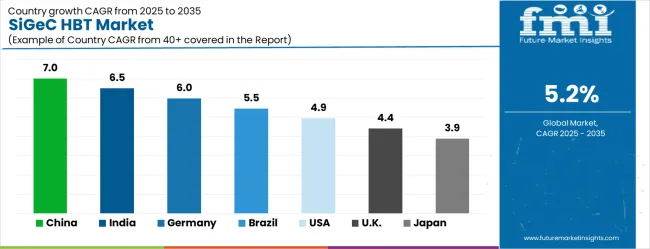
| Country | CAGR (2025-2035) |
|---|---|
| China | 7.0% |
| India | 6.5% |
| Germany | 6.0% |
| Brazil | 5.5% |
| USA | 4.9% |
| United Kingdom | 4.4% |
| Japan | 3.9% |
The SiGe:C HBT market is experiencing steady growth globally, with China leading at a 7.0% CAGR through 2035, driven by the expanding telecommunications infrastructure, growing investment in 5G network deployment, and significant government support for advanced semiconductor manufacturing development. India follows at 6.5%, supported by large-scale mobile communication expansion, growing consumer electronics manufacturing, and increasing investment in wireless communication technology development. The USA shows growth at 4.9%, emphasizing technological innovation and premium RF component development for aerospace and defense applications.
Brazil records 5.5%, focusing on telecommunications infrastructure modernization and growing mobile communication market expansion. Germany demonstrates 6.0% growth, prioritizing automotive communication systems and industrial IoT applications. The United Kingdom exhibits 4.4% growth, emphasizing satellite communication development and advanced RF technology research. Japan shows 3.9% growth, supported by its established semiconductor industry presence and innovative high-frequency component development.
The report covers an in-depth analysis of 40+ countries with top-performing countries highlighted below.
The SiGe:C HBTmarket in China is projected to exhibit strong growth with a CAGR of 7.0% through 2035, driven by expanding 5G network infrastructure and rapidly growing mobile communication equipment manufacturing, supported by government technology advancement initiatives and comprehensive telecommunications development programs. The country's massive communication equipment production and increasing investment in advanced semiconductor technologies are creating substantial demand for high-performance RF solutions. Major telecommunications equipment manufacturers and semiconductor companies are establishing comprehensive SiGe:C HBT production capabilities to serve both domestic infrastructure development and international export markets.
Revenue from SiGe:C HBT components in India is expanding at a CAGR of 6.5%, supported by the country's large-scale mobile communication market expansion, growing consumer electronics manufacturing capabilities, and increasing investment in wireless communication technology development, focusing on infrastructure modernization and connectivity enhancement. The country's comprehensive telecommunications growth and growing semiconductor assembly operations are driving demand for sophisticated RF component capabilities. International semiconductor companies and domestic electronics manufacturers are establishing extensive production and assembly capabilities to address the growing demand for advanced communication components.
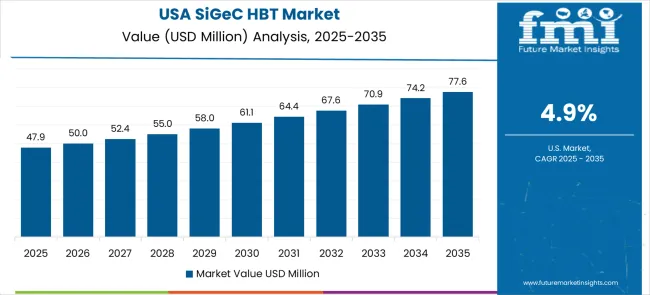
Demand for SiGe:C HBT components in the USA is growing at a CAGR of 4.9%, supported by the country's advanced semiconductor industry, strong emphasis on technological innovation, and robust investment in aerospace and defense communication systems requiring high-performance RF components. The nation's mature semiconductor manufacturing sector and sophisticated defense applications are driving advanced SiGe:C HBT adoption throughout the technology supply chain. Leading semiconductor companies and defense contractors are investing extensively in premium component development and advanced fabrication methods to serve both commercial and military markets.
Revenue from SiGe:C HBT components in Brazil is expected to expand at a CAGR of 5.5%, driven by expanding telecommunications infrastructure modernization, increasing mobile communication penetration, and growing investment in wireless communication technology deployment, focusing on network capacity enhancement and coverage expansion. The country's growing telecommunications sector and modernization of communication networks are supporting demand for advanced RF technologies across major urban centers. Telecommunications operators and equipment suppliers are establishing comprehensive technology adoption programs to serve both domestic market development and regional connectivity improvement initiatives.
The SiGe:C HBT market in Germany is anticipated to grow at a CAGR of 6.0%, supported by the country's strong automotive industry, advanced industrial automation sector, and strategic focus on Industry 4.0 development requiring sophisticated communication and sensing technologies. Germany's established engineering expertise and emphasis on high-quality manufacturing are driving demand for specialized RF solutions focusing on automotive radar, industrial monitoring, and machine-to-machine communication applications. Technology companies are investing in comprehensive development capabilities to serve both automotive and industrial markets with high-reliability RF components.
Revenue from SiGe:C HBT components in the United Kingdom is forecasted to expand at a CAGR of 4.4%, driven by the country's strong aerospace and defense sector, government support for satellite communication development, and comprehensive research initiatives in advanced RF technology focusing on space communication and radar applications. The UK's mature aerospace industry and technological expertise are supporting investment in sophisticated RF components throughout major defense and space technology centers. Industry organizations are establishing comprehensive development programs to serve both domestic defense requirements and international aerospace export markets with specialized high-frequency components.
<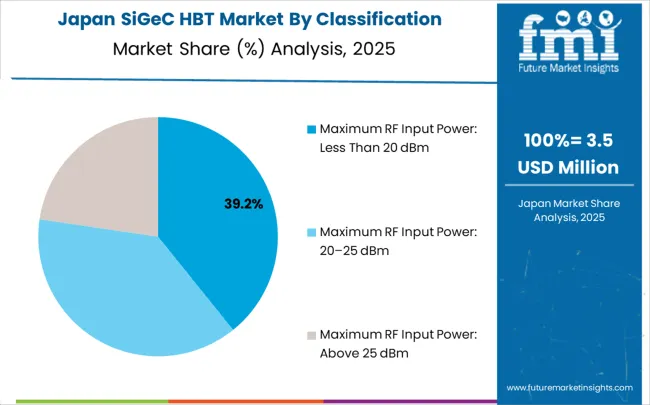
Demand for SiGe:C HBT components in Japan is expected to grow at a CAGR of 3.9%, supported by the country's established semiconductor industry leadership, advanced consumer electronics manufacturing, and strong focus on precision engineering requiring sophisticated high-frequency components for communication and sensing applications. Japan's sophisticated technology development culture and emphasis on manufacturing excellence are driving demand for specialized RF components, including automotive radar, consumer communication devices, and industrial sensing systems. Leading electronics companies are investing in the development of advanced components to serve commercial consumer markets, automotive applications, and industrial automation segments with high-performance RF solutions.
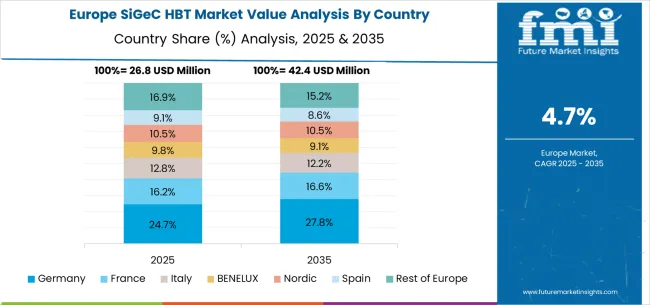
The SiGe:C HBT market in Europe is projected to grow from USD 24.0 million in 2025 to USD 39.8 million by 2035, registering a CAGR of 5.2% over the forecast period. Germany is expected to maintain its leadership position with a 32.0% market share in 2025, growing to 33.0% by 2035, supported by its strong automotive electronics industry, advanced industrial automation sector, and comprehensive RF technology research programs serving major European communication and automotive markets.
The United Kingdom follows with a 25.0% share in 2025, projected to reach 24.5% by 2035, driven by robust aerospace and defense sector demand, an established satellite communication industry, and government investment in space technology development, combined with strong research and development activities in advanced RF technologies. France holds an 18.0% share in 2025, expected to reach 18.5% by 2035, supported by growing aerospace industry applications and increasing adoption of advanced communication systems in defense and civilian markets.
Italy commands a 10.0% share in 2025, projected to reach 10.2% by 2035, while Spain accounts for 6.0% in 2025, expected to reach 6.3% by 2035. The Netherlands maintains a 3.5% share in 2025, growing to 3.7% by 2035. The Rest of Europe region, including Nordic countries, Eastern Europe, Portugal, Belgium, Switzerland, and Austria, is anticipated to maintain a stable presence, with its collective share remaining at 5.5% through 2035, attributed to specialized applications in telecommunications infrastructure and growing adoption of industrial communication systems across Eastern European markets implementing technology modernization programs.
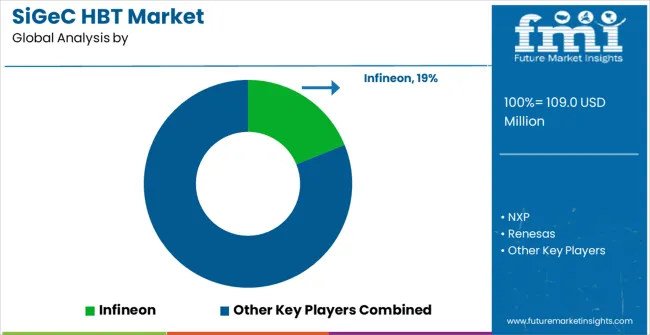
The SiGe:C HBT market is characterized by competition among established semiconductor companies, specialized RF component manufacturers, and integrated device solution providers. Companies are investing in advanced fabrication technology research, process optimization, quality control systems, and comprehensive product portfolios to deliver high-performance, reliable, and cost-effective SiGe:C HBT semiconductor solutions. Innovation in carbon doping techniques, heterojunction design optimization, and thermal management integration is central to strengthening market position and competitive advantage.
Infineon leads the market with a strong market share, offering comprehensive RF semiconductor solutions with a focus on automotive, industrial, and communication applications requiring high-performance and reliability. NXP provides specialized RF power transistors and amplifiers with an emphasis on automotive radar, wireless infrastructure, and consumer electronics applications. Renesas delivers innovative semiconductor solutions with a focus on automotive and industrial markets requiring advanced RF performance. ST specializes in RF and microwave components for telecommunications, automotive, and consumer electronics applications. Qorvo focuses on advanced RF solutions for wireless communication, aerospace, and defense applications requiring superior performance characteristics.
| Items | Values |
|---|---|
| Quantitative Units (2025) | USD 109 million |
| Input Power Rating | Maximum RF Input Power: Less Than 20 dBm, Maximum RF Input Power: 20–25 dBm, Maximum RF Input Power: Above 25 dBm, Others |
| Application | WLAN, UWB, and Bluetooth, Satellite Communication, Multimedia |
| Regions Covered | North America, Europe, Asia Pacific, Latin America, Middle East & Africa |
| Countries Covered | United States, Canada, United Kingdom, Germany, France, China, Japan, India, Brazil, Australia and 40+ countries |
| Key Companies Profiled | Infineon, NXP, Renesas, ST, and Qorvo |
| Additional Attributes | Dollar sales by input power rating and application category, regional demand trends, competitive landscape, technological advancements in SiGe:C fabrication, carbon doping innovation, heterojunction optimization, and thermal management development |
The global SiGe:C HBT market is estimated to be valued at USD 109.0 million in 2025.
The market size for the SiGe:C HBT market is projected to reach USD 181.0 million by 2035.
The SiGe:C HBT market is expected to grow at a 5.2% CAGR between 2025 and 2035.
The key product types in SiGe:C HBT market are maximum rf input power: less than 20 dbm, maximum rf input power: 20–25 dbm and maximum rf input power: above 25 dbm.
In terms of application, wlan, uwb, and bluetooth segment to command 42.0% share in the SiGe:C HBT market in 2025.






Our Research Products

The "Full Research Suite" delivers actionable market intel, deep dives on markets or technologies, so clients act faster, cut risk, and unlock growth.

The Leaderboard benchmarks and ranks top vendors, classifying them as Established Leaders, Leading Challengers, or Disruptors & Challengers.

Locates where complements amplify value and substitutes erode it, forecasting net impact by horizon

We deliver granular, decision-grade intel: market sizing, 5-year forecasts, pricing, adoption, usage, revenue, and operational KPIs—plus competitor tracking, regulation, and value chains—across 60 countries broadly.

Spot the shifts before they hit your P&L. We track inflection points, adoption curves, pricing moves, and ecosystem plays to show where demand is heading, why it is changing, and what to do next across high-growth markets and disruptive tech

Real-time reads of user behavior. We track shifting priorities, perceptions of today’s and next-gen services, and provider experience, then pace how fast tech moves from trial to adoption, blending buyer, consumer, and channel inputs with social signals (#WhySwitch, #UX).

Partner with our analyst team to build a custom report designed around your business priorities. From analysing market trends to assessing competitors or crafting bespoke datasets, we tailor insights to your needs.
Supplier Intelligence
Discovery & Profiling
Capacity & Footprint
Performance & Risk
Compliance & Governance
Commercial Readiness
Who Supplies Whom
Scorecards & Shortlists
Playbooks & Docs
Category Intelligence
Definition & Scope
Demand & Use Cases
Cost Drivers
Market Structure
Supply Chain Map
Trade & Policy
Operating Norms
Deliverables
Buyer Intelligence
Account Basics
Spend & Scope
Procurement Model
Vendor Requirements
Terms & Policies
Entry Strategy
Pain Points & Triggers
Outputs
Pricing Analysis
Benchmarks
Trends
Should-Cost
Indexation
Landed Cost
Commercial Terms
Deliverables
Brand Analysis
Positioning & Value Prop
Share & Presence
Customer Evidence
Go-to-Market
Digital & Reputation
Compliance & Trust
KPIs & Gaps
Outputs
Full Research Suite comprises of:
Market outlook & trends analysis
Interviews & case studies
Strategic recommendations
Vendor profiles & capabilities analysis
5-year forecasts
8 regions and 60+ country-level data splits
Market segment data splits
12 months of continuous data updates
DELIVERED AS:
PDF EXCEL ONLINE

Thank you!
You will receive an email from our Business Development Manager. Please be sure to check your SPAM/JUNK folder too.
Chat With
MaRIA